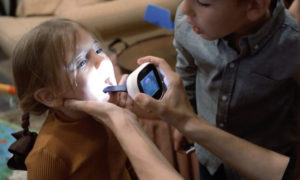How Hybrid Models Transform Value-Based Care

As healthcare continues to shift towards value-based, what is the role of hybrid models in supporting the transition? How does value-based hybrid care increase member engagement, ensure equitable healthcare access, and support clinicians?
- test
- test2
- rtedd
- sadssd
- sdsds
- dsdsd
1Our recent Bright Spots in Healthcare webinar featured Dr. Donna O’Shea, VP of Population Health and Value-Based Care at UnitedHealthcare, Dr. Erika Pabo, VP Transformation & Central Operations at Centerwell/Humana, Tracy Rico, RN, Director of Virtual Care Services at Centene, and Elizabeth Hyatt, TytoCare’s Director of Payor Solutions.
1.123sa
Wrapping care around members
Dr. O’Shea began the discussion by stating how fundamental primary care access is to overall health. She emphasized the need for a team-based approach that combines virtual services with in-person care when needed.
Tracy Rico continued, stating that virtual services are a means of wrapping care around members and can be encouraged as the first line of care. Virtual care must align with members’ electronic health records to ensure care continuity and reinforce the patient-provider relationship.
TytoCare helped the carrier increase engagement and virtual care adoption utilizing behavioral science, leading to a 40% reduction in ED utilization and lowering overall spend.
Care for all populations
Hybrid care models can address the health needs of underserved communities. Elizabeth Hyatt discussed TytoCare’s partnership with a national carrier that sought to lower cost of care, reduce ER spend, and improve member convenience among underserved populations. TytoCare helped the carrier increase engagement and virtual care adoption utilizing behavioral science, leading to a 40% reduction in ED utilization and lowering overall spend.
Dr. Pabo emphasized the need to avoid stereotypes regarding diverse populations and innovative care. Seniors, for example, have long been considered less technologically savvy, while they are actually a heterogeneous population, many of whom use tech widely. Primary care at home is critical for seniors, particularly those who can’t make it to a clinic. Dr. Pabo shared optimism about hybrid care’s future for seniors and other populations. When healthcare payers make virtual care easy to access and ensure it delivers value, seniors and other populations often prefer it.
Hybrid care’s key components
In the webinar, the panel discussed the importance of quality value-based hybrid care, cautioning that when done poorly, hybrid care can risk further fragmenting care. Successful value-based care puts patients at their center, whether care is delivered virtually, in person, or both.
While much has been invested to make brick-and-mortar healthcare as seamless as possible, we must do the same for primary care at home, lest we create further inequity in its delivery. This requires ensuring broadband internet access, providing connection hotspots, and distributing tablets to members who need them. It also means offering training and education in the use of technology for virtual care. As Tracy explained, we must assess members’ digital literacy – do they have the device they need and know how to use it? Do they have digital connectivity?
Dr. Pabo expressed that the increased weight of member experience in value-based care is a good thing. Experience is a leading indicator of many components of the healthcare journey. Positive healthcare experiences increase engagement and utilization, which brings about improved health outcomes. We must invest in people, process, and technology to create a frictionless experience that minimizes barriers. Healthcare should meet members where they are, leveraging the channels they already know and use.
Meeting members where they are
As Dr. O’Shea explained, regular primary care access helps members stay healthy. Hybrid care has the potential to get members engaged in their health and minimize reliance on the ED and urgent care. Tracy added that by serving patients within their communities, caregivers get a better sense of their environment and its challenges. Home health care for hospital-discharged patients is another means of follow-up that ensures their care plan is being followed successfully. Getting the full picture about patients helps build the trust relationship.
We must also consider social drivers of health. Members who struggle with housing or food insecurity will likely find hybrid care access an added challenge. Including such issues in a patient’s electronic health record enables those providing care to those members on the ground to remain in the know.
Elizabeth related TytoCare’s experience in bringing virtual care to underserved students in Detroit’s public schools, engaging families and addressing healthcare inequities. Another benefit was reduced absenteeism rates, which helped stabilize school funding.
Alleviating clinician challenges
As Dr. Pabo explained, virtual care can have a positive impact on clinicians and address their personal and professional challenges. It can lower burnout by supporting a healthier work-life balance in which clinicians can care for patients without being limited to an in-office setting.
Hybrid care reassures clinicians that they are part of an entire team of caregivers involved in a member’s health journey. When hybrid models work hand in hand with value-based care, their potential impact on easing provider burnout is maximized.
However, just as members need support to make the move towards hybrid care, clinicians require training and assistance as well. Most clinicians’ training is based on treating patients in person, with only brief supplemental training in virtual care. Teaching clinicians about virtual care and the best ways to deliver it will help overcome barriers to their using it. Appropriate training enables clinicians to embrace virtual care, which, in turn, encourages members to utilize it.
A hybrid future ahead
Dr. O’Shea discussed the role of virtual care in augmenting specialty care. In her experience, virtual visits for migraine management, dermatology, and GI care, and more have received positive feedback from providers and members alike. Long wait times and travel distances can hinder members from seeking out lifesaving specialty visits. Innovative devices for virtual care can support members with chronic conditions in a setting they’re comfortable with.
While challenges to virtual care access exist for rural and underserved populations, they can and must be addressed. We should find out why members are struggling to access care and help support them. Grants are available to organizations that seek to improve virtual care access and require funding to enable connectivity.
Hybrid models have already made a major impact on value-based care. As we look toward healthcare’s future, hybrid models will no doubt continue to shape the shift to value-based care.
Watch the webinar to learn more.

